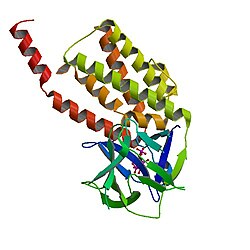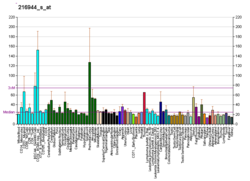Inositol 1,4,5-trisphosphate receptor type 1 is a protein that in humans is encoded by the ITPR1 gene.[5][6][7][8][9]
- ^ a b c GRCh38: Ensembl release 89: ENSG00000150995 – Ensembl, May 2017
- ^ a b c GRCm38: Ensembl release 89: ENSMUSG00000030102 – Ensembl, May 2017
- ^ "Human PubMed Reference:". National Center for Biotechnology Information, U.S. National Library of Medicine.
- ^ "Mouse PubMed Reference:". National Center for Biotechnology Information, U.S. National Library of Medicine.
- ^ Yamada N, Makino Y, Clark RA, Pearson DW, Mattei MG, Guénet JL, Ohama E, Fujino I, Miyawaki A, Furuichi T (Sep 1994). "Human inositol 1,4,5-trisphosphate type-1 receptor, InsP3R1: structure, function, regulation of expression and chromosomal localization". The Biochemical Journal. 302 (Pt 3): 781–90. doi:10.1042/bj3020781. PMC 1137299. PMID 7945203.
- ^ Nucifora FC, Li SH, Danoff S, Ullrich A, Ross CA (Sep 1995). "Molecular cloning of a cDNA for the human inositol 1,4,5-trisphosphate receptor type 1, and the identification of a third alternatively spliced variant". Brain Research. Molecular Brain Research. 32 (2): 291–6. doi:10.1016/0169-328X(95)00089-B. PMID 7500840.
- ^ van de Leemput J, Chandran J, Knight MA, Holtzclaw LA, Scholz S, Cookson MR, Houlden H, Gwinn-Hardy K, Fung HC, Lin X, Hernandez D, Simon-Sanchez J, Wood NW, Giunti P, Rafferty I, Hardy J, Storey E, Gardner RJ, Forrest SM, Fisher EM, Russell JT, Cai H, Singleton AB (Jun 2007). "Deletion at ITPR1 underlies ataxia in mice and spinocerebellar ataxia 15 in humans". PLOS Genetics. 3 (6): e108. doi:10.1371/journal.pgen.0030108. PMC 1892049. PMID 17590087.
- ^ Iwaki A, Kawano Y, Miura S, Shibata H, Matsuse D, Li W, Furuya H, Ohyagi Y, Taniwaki T, Kira J, Fukumaki Y (Jan 2008). "Heterozygous deletion of ITPR1, but not SUMF1, in spinocerebellar ataxia type 16". Journal of Medical Genetics. 45 (1): 32–5. doi:10.1136/jmg.2007.053942. PMID 17932120. S2CID 7730102.
- ^ "Entrez Gene: ITPR1 inositol 1,4,5-triphosphate receptor, type 1".







